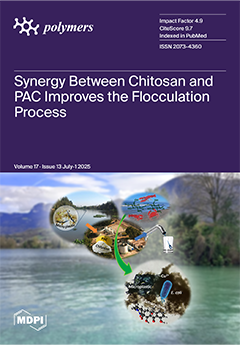This study presents colorless polyimides (PIs) suitable for use as plastic substrates in flexible displays, designed to be compatible with controlled soft adhesion and easy delamination (temporary adhesion) processes. For this purpose, we focused on a PI system derived from norbornane-2-spiro-α-cyclopentanone-α′-spiro-2″-norbornane-5,5″,6,6″-tetracarboxylic dianhydride (CpODA)
[...] Read more.
This study presents colorless polyimides (PIs) suitable for use as plastic substrates in flexible displays, designed to be compatible with controlled soft adhesion and easy delamination (temporary adhesion) processes. For this purpose, we focused on a PI system derived from norbornane-2-spiro-α-cyclopentanone-α′-spiro-2″-norbornane-5,5″,6,6″-tetracarboxylic dianhydride (CpODA) and 2,2′-bis(trifluoromethyl)benzidine (TFMB). This system was selected with the aim of exhibiting excellent optical transparency and low linear coefficient of thermal expansion (CTE) properties. However, fabricating this PI film via the conventional two-step process was challenging because of crack formation. In contrast, modified one-pot polymerization at 200 °C using a combined catalyst resulted in a homogeneous solution of PI with an exceptionally high molecular weight, yielding a flexible cast film. The solubility of PI plays a crucial role in its success. This study delves into the mechanism behind the significant catalytic effect on enhancing molecular weight. The CpODA/TFMB PI cast film simultaneously achieved very high optical transparency, an extremely high glass transition temperature (
Tg = 411 °C), a significantly low linear coefficient of thermal expansion (CTE = 16.7 ppm/K), and sufficient film toughness, despite the trade-off between low CTE and high film toughness. The CpODA/TFMB system was modified by copolymerization with minor contents of another cycloaliphatic tetracarboxylic dianhydride, 5,5′-(1,4-phenylene)-
exo-bis(hexahydro-4,7-methanoisobenzofuran-
cis-exo-1,3-dione) (BzDAxx). This approach was effective in improving the film toughness without sacrificing the low CTE and other target properties. The peel strengths (
σpeel) of laminates comprising surface-modified glass substrates and various colorless PI films were measured to evaluate the compatibility with the temporary adhesion process. Most colorless PI films studied were found to be incompatible. Additionally, no correlation between
σpeel and PI structure was observed, making it challenging to identify the structural factors influencing
σpeel control. Surprisingly, a strong correlation was observed between
σpeel and CTE of the PI films, suggesting that the observed solid–solid lamination is closely linked to the unexpectedly high surface mobility of the PI films. The laminate using CpODA(90);BzDAxx(10)/TFMB copolymer exhibited suitable adhesion strength for the temporary adhesion process, while meeting other target properties. The modified one-pot polymerization method significantly contributed to the development of colorless PIs suitable for plastic substrates.
Full article






